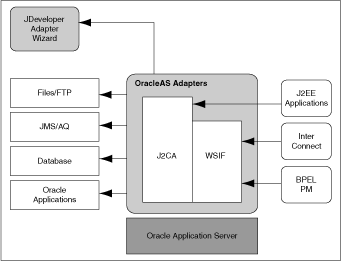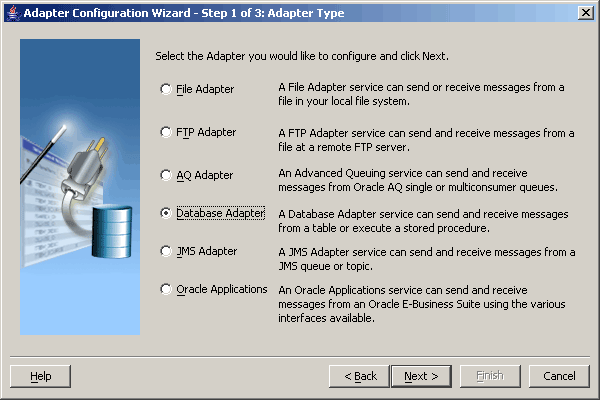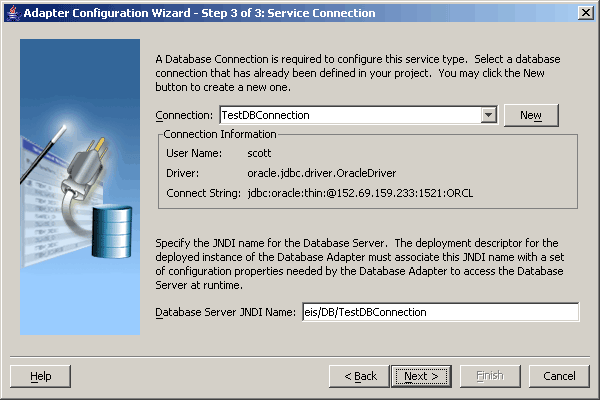|
Oracle® Application Server Adapter Concepts Guide
10g Release 2 (10.1.2) B14058-04 |
|
 Previous |
 Next |
|
Oracle® Application Server Adapter Concepts Guide
10g Release 2 (10.1.2) B14058-04 |
|
 Previous |
 Next |
Technology adapters integrate Oracle Application Server with transport protocols, data stores, and messaging middleware. These adapters include OracleAS Adapter for FTP, OracleAS Adapter for JMS, OracleAS Adapter for Databases, OracleAS Adapter for Advanced Queuing, and OracleAS Adapter for Files.
This chapter contains the following topics:
Technology adapters are based on J2EE Connector Architecture (J2CA) 1.5 standards and deployed as a resource adapter in the same Oracle Application Server Containers for J2EE (OC4J) container as BPEL Process Manager. OracleAS Adapter for Oracle Applications consists of the same architecture as the technology adapters. Figure 2-1 illustrates the architecture of technology adapters.
Figure 2-1 Technology Adapter Architecture

During design time, technology adapters use Oracle JDeveloper to generate the adapter metadata. The request-response service, also known as J2CA outbound interaction, and the event notification service, also known as J2CA inbound interaction, are described in J2CA WSIF WSDL files. These WSDL files consist of J2CA extension elements. The J2CA WSDL elements are used by the Adapter Framework to seamlessly integrate the J2CA 1.5 resource adapter with the BPEL Process Manager. For more information about integration of technology adapters with BPEL Process Manager, refer to Chapter5, "Adapter Integration with BPEL Process Manager".
Example 2-1 Generating WSDL Files for OracleAS Adapter for Databases
Using JDeveloper, you can configure OracleAS Adapter for Databases. This adapter helps you perform data manipulation operations, call stored procedures or functions, and publish database events in real time. To configure adapter definitions, select OracleAS Adapter for Databases, as shown in Figure 2-2.
Figure 2-2 Selecting the Database Adapter

Figure 2-3 shows how to browse to select the required tables for the adapter.
Figure 2-4 shows how to specify the WSDL settings for OracleAS Adapter for Databases.
Next, you need to establish a database connection, select an operation type and select the required tables. The run-time connection parameters are specified in the oc4j-ra.xml file and linked to a Java Naming and Directory Interface (JNDI) name, which is specified during design time. Figure 2-5 shows the creation of a new database connection.
Figure 2-5 Creating a New Database Connection

Finally, JDeveloper generates a WSDL file with the J2CA binding for the OracleAS Adapter for Databases, as shown in Figure 2-4:
|
Note: You can make technology adapters handle large XML payloads by including an additional setting inbpel.xml, under the activation agent as shown in the following example:
<activationAgents>
<activationAgent ...>
...
<property name="postAsString">true</property>
...
|
The run-time component of technology adapters is the J2CA 1.5 resource adapter for the specific back-end application. Technology adapters are deployed in OC4J, which is the J2CA container of Oracle Application Server. The BPEL Process Manager integrates with these J2CA 1.5 adapters through the Adapter Framework, which converts Web service messages into J2CA interactions and back.
BPEL Process Manager uses Adapter Framework to integrate the request-response service (J2CA outbound interaction) with a BPEL Invoke activity and publish the adapter events to a BPEL Receive activity. For more information about integration with the BPEL Process Manager, refer to Chapter5, "Adapter Integration with BPEL Process Manager".
|
Note: Technology adapters can be integrated only with Business Process Execution Language for Web Services (BPEL) Process Manager. |
Technology adapters are deployed as J2CA 1.5 resource adapters within the same OC4J container as BPEL Process Manager during installation. Although, technology adapters are physically deployed as J2CA 1.5 resource adapters, their logical deployment involves creating the Connection Factory entries for the J2CA 1.5 resource adapter by editing the oc4j-ra.xml file and using JDeveloper during design time. Using JDeveloper, you specify the JNDI name, which acts as a placeholder for the connection used when your service is deployed to the BPEL Server. This enables you to use different databases for development and later production. However, for the logical deployment changes to take effect, the OC4J container process should be restarted.